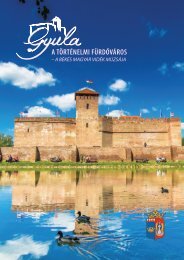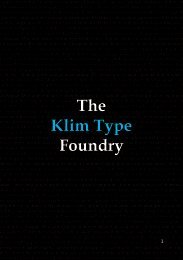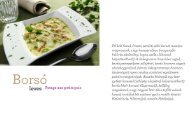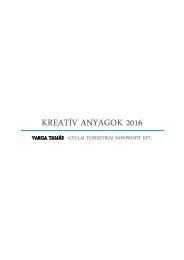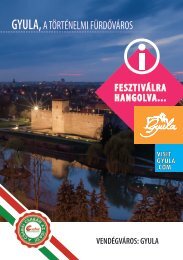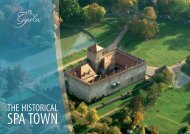varosbemutato-kiadvany-03-megtekintes-minden-oldal
You also want an ePaper? Increase the reach of your titles
YUMPU automatically turns print PDFs into web optimized ePapers that Google loves.
THE HISTORICAL<br />
SPA TOWN
Location<br />
Gyula lies in southeast Hungary,<br />
along the Romanian border, in<br />
the South Great Plain. The climate<br />
is continental with pretty<br />
cold winter and hot summer.<br />
The annual amount of precipitation<br />
is 550-600 mm.<br />
The annual number of<br />
sunny hours is also high in<br />
national terms.<br />
Total population:<br />
31,800 inhabitants<br />
Population density:<br />
124.32 per km2<br />
Area: 255.6 km2
The region of<br />
Körös-Rivers<br />
Gyula was built not far from the<br />
junction of Fekete- and Fehér-<br />
Körös (Black and White Cris)<br />
rivers, on the left bank of the<br />
latter, in a wonderful area,<br />
which has been declared a<br />
national park in part and was<br />
inhabited already in prehistoric<br />
age.<br />
We have 33 locally protected<br />
natural areas and elements<br />
and 215 unique landscape<br />
values. The riverbanks provide<br />
a great location for<br />
those, who are attracted by<br />
the undisturbed, peaceful<br />
nature out of the town.
The Fehér-Körös (White Cris) and<br />
the Fekete-Körös (Black Cris) belong<br />
to the rivers of the cleanest<br />
water in Europe. Along these<br />
rivers, we meet two popular<br />
holiday centres: Szanazug at<br />
their junction within easy<br />
reach even by bicycle and<br />
Városerdő going upwards<br />
along the Fekete-Körös.
The Beginnings<br />
The life-giving water attracted<br />
the first settlers to this area. Later<br />
on, also the street structure of<br />
the settlement, which has 32<br />
thousand inhabitants now,<br />
was formed based on the onetime<br />
water system. Reeds,<br />
marshes, meadows and gallery<br />
forests dominated over<br />
the landscape. Wetlands with<br />
lush vegetation and rich fauna<br />
determined the view.
The look of the town is determined<br />
by its surface waters:<br />
Fehér-Körös (White Cris) separating<br />
Gyula from Gyulavári,<br />
Élővíz-csatorna (Live-water<br />
Canal) connecting three settlements<br />
and string of lakes /<br />
ponds surrounding the town.<br />
The first people appeared<br />
along the Fehér-Körös on the<br />
higher, flood free areas at the<br />
time of the Neolithic age.<br />
The name of Körös-culture<br />
refers to it. Artefacts from<br />
the copper, bronze and iron<br />
ages prove the existence of<br />
former settlements.
History:<br />
The medieval town<br />
In 1332, the settlement was<br />
mentioned already with the<br />
name of Gyula in the chronicle.<br />
Gyula began to develop into a<br />
town in the period of the Anjou<br />
Kings. The construction<br />
of the fortress started in<br />
1405. The holders of the fort<br />
were king and the members<br />
of royal families. The pre-<br />
Ottoman Gyula was in its<br />
prime at the early 16th century.<br />
In 1525, it had already<br />
about 3,000 inhabitants.<br />
After the siege of 1566, the<br />
Ottomans ruled the town<br />
for 129 years.
After the ottoman<br />
occupation<br />
The fortress and the town were<br />
deliberated in January 1695.<br />
By this, it became possible to<br />
repatriate permanently.<br />
The history of Gyula after the<br />
Ottoman rule starts from<br />
1714. The wars partly destroyed<br />
the population and<br />
partly drove them away.<br />
The new holder of the estate<br />
John George Harruckern<br />
reorganized the life in<br />
the area.
Multinationality<br />
Romanian and German population<br />
settled in Gyula from the<br />
1720s, which was depopulated<br />
after forcing out the Ottomans.<br />
The German settlers brought<br />
such work and industrial culture<br />
with them, which contributed<br />
to the embourgeoisement<br />
greatly.
While owing to the Romanianspeaking<br />
population, Gyula became<br />
the centre of Romanian<br />
population in Hungary thereby<br />
strengthening the tourism<br />
being one of the most important<br />
economic sectors of the<br />
town. Town districts, buildings<br />
and churches named after<br />
them keep their memories<br />
up to now faithfully.
Two Centres of the County:<br />
Gyula and Békéscsaba<br />
Gyula was the county town of<br />
Békés county for almost 500<br />
years. Though, since 1950,<br />
Békéscsaba has owned this title,<br />
a great part of the county<br />
institutions stayed in Gyula.<br />
• Gyula Regional Court<br />
• Békés County Public Prosecutor’s Office<br />
• Békés County Bar Association<br />
• Pándy Kálmán County Hospital<br />
• The Hungarian National Archives Békés<br />
County Archives<br />
• Körös Valley District Environment and<br />
Water Directorate<br />
• Educational institutions<br />
(primary, secondary and higher)
Great Sons<br />
Ferenc Erkel<br />
The founding father of the<br />
Hungarian national grand opera<br />
and set the Hungarian<br />
national anthem to music.<br />
György Kohán<br />
The Kossuth Prize-winner<br />
painter of the Great Plain.<br />
His name and works are<br />
kept by the art gallery in<br />
the Göndöcs Park.
Mihály Munkácsy<br />
The world famous painter began<br />
his career within the walls<br />
of the Almásy Mansion.<br />
Zoltán Bay<br />
One of the greatest Hungarian<br />
physicists, whose<br />
name is linked with creating<br />
electron multiplier,<br />
lunar radar and a new definition<br />
of the metre.
Agriculture and Food<br />
Industry<br />
Agriculture and food industry<br />
as well as tourism are the main<br />
pillars of our economy.<br />
The Körös-Maros (Cris-Mures)<br />
alluvial deposit provides highquality<br />
arable soils, which<br />
create ideal conditions for<br />
cultivation of plants and animal<br />
husbandry based on it.
’Gyulai’ sausage<br />
We put the launch of the meat<br />
trade in Gyula to 1868 – the first<br />
abattoir of Gyula was opened<br />
then.<br />
The Gyulahús Kft. is our biggest<br />
food company and one<br />
of the biggest meat processing<br />
companies in Hungary.<br />
World famous product:<br />
’Gyulai’ sausage
Traditional products<br />
The Gyulai Pálinka Manufactory,<br />
which has gained an international<br />
reputation, is the worthy<br />
follower of the tradition, where<br />
their distillates are produced<br />
from local fruits.<br />
The handmade bonbons and<br />
chocolates of the Cadeau<br />
Bonbon Manufactory are<br />
available also in Budapest in<br />
addition to Gyula.<br />
In Békés County a significant<br />
number of beekeepers<br />
work. Their products are<br />
enjoying great popularity<br />
within and outside the borders<br />
of the country.
Tourism<br />
Gyula is the fifth most popular<br />
tourist destination in Hungary<br />
for domestic tourists.<br />
The visiting frequency of the<br />
town was increasing in recent<br />
years. In 2014, people visiting<br />
here spent 430,000 overnight<br />
stays in all accommodations<br />
of Gyula.<br />
4,800 beds altogether<br />
ranges from four-star hotels,<br />
through smaller guest<br />
houses to apartment houses<br />
with different categories.<br />
Accomodations with descriptions:<br />
WWW.VISITGYULA.COM
Industry in Gyula<br />
The FaFém Bútor Zrt. furniture<br />
factory:<br />
Founded in 1950 introduced the<br />
production of metal frame office<br />
furniture in Hungary.<br />
Dürer Printing House:<br />
Estabilished by Printer István<br />
Nagy P. in 1935. It has been<br />
awarded a number of prestigious<br />
professional recognitions.<br />
Lovász Forgácsoló Kft.:<br />
Our biggest metallurgic<br />
company dealing with metal<br />
cutting, which as a Mitsubishi<br />
Carbide partner manufactures<br />
and sells tool parts,<br />
automotive components<br />
and electronic components<br />
throughout Europe.
Gyulai Várfürdő<br />
Situated in the 8.5-hectare park<br />
of the former Almásy Mansion.<br />
The only five-star rated facility in<br />
lido, water park and spa categories<br />
alike in the country.<br />
The water of the baths has belonged<br />
to the healing waters<br />
since 1968 also officially.<br />
The baths obtained a medicinal<br />
baths certification in<br />
1971, while its environs was<br />
certified as a health resort in<br />
1984.<br />
5,000-square-metre facility,<br />
16 pools
The therapeutic section of the<br />
Gyulai Várfürdő was opened to<br />
the general public wishing to<br />
recover in August 1968. Still in<br />
the same year, head physician<br />
Dr. Margit Aranyosi summarized<br />
her experiences with the<br />
medicinal bath treatment<br />
of 1678 patients and submitted<br />
it to the National Institute<br />
of Public Hygiene.<br />
Where, based on that, the<br />
water of Gyula No. 1 well<br />
was granted healing waters<br />
status. Then, in 1971, the<br />
Ministry of Health qualified<br />
our baths as a spa performing<br />
national duties. In<br />
compliance with the applicable<br />
legislation.
AquaPalace<br />
Having enhanced with a new<br />
family water park named Aqua-<br />
Palace, the Gyula Castle Spa<br />
has become the newest, wellequipped,<br />
European standard<br />
lido, spa and water park<br />
complex in the South Great<br />
Plain, which provides perfect<br />
entertainment, in all seasons,<br />
for the visitors of every<br />
generation looking for recreation.<br />
The rightly famous<br />
four-star baths, the Gyula<br />
Castle Spa pampers, relaxes,<br />
exercises and heals.<br />
Slides<br />
• family slide<br />
• “light tunnel” body slide<br />
• “upwards inclining / drop<br />
ping” in-line tube slide
Pools<br />
• Toddler and kiddie pool:<br />
2 water cannons, pirate ship water<br />
slide, 2 animal spouts<br />
• Recreational swimming pool<br />
• Adventure pool:<br />
12 water jet massage benches,<br />
water curtain, lazy river, 2 water<br />
jet massage cabins, 6 neck show<br />
ers, pool floor jets, geysers<br />
• Plunge pool to the saunas<br />
• Whirlpool spa:<br />
4 water jet massage benches,<br />
8 pool floor jets Diving pool<br />
• Saunas:<br />
• Aromatherapy sauna<br />
• Infrared sauna chamber<br />
• Steam chamber<br />
• Finnish sauna<br />
• Playgrounds<br />
• Pool bar<br />
• Mother-baby room
The healing Water<br />
The thermal mineral waters contain<br />
various macro elements and<br />
microelements. Due to the bathing,<br />
the various ingredients of<br />
healing waters get into the<br />
body through the skin, while<br />
other elements such as sulphur<br />
by means of inhalation.<br />
According to the latest water<br />
chemistry tests, the water<br />
of Várfürdő No. 1 well contains<br />
2620 mg/l minerals,<br />
and owing to its composition,<br />
it is sodium hydrogen<br />
carbonated thermal water<br />
with a significant metasilicic<br />
acid content. Its temperature<br />
is 69 °C measured at<br />
the outflow.
Effects of the sodium<br />
hydrogen carbonated<br />
healing waters:<br />
It increases the regeneration<br />
capacity of the body, has an analgesic<br />
effect, reduces allergic<br />
reactions, has a tranquillizing<br />
on the nervous system, reduces<br />
sleep disturbances, reduces<br />
inflammatory processes at an<br />
appropriate temperature, by<br />
inhalation helps coughing<br />
up respiratory secretions as<br />
well as reduces muscle tension.<br />
As a result of bathing,<br />
the metasilicic acid is deposited<br />
on the skin as a fine<br />
film. The skin feels soapy<br />
and oily, which is especially<br />
useful in case of such<br />
skin diseases as lichen,<br />
psoriasis, eczema and<br />
other allergic dermatitis.
To whom can be recommended<br />
the water cure with the<br />
healing waters of Gyula?<br />
Gynaecological diseases:<br />
• chronic oophoritis<br />
• chronic inflammation of fallopian<br />
tube and ligament<br />
• certain forms of infertility<br />
Urologic diseases:<br />
• chronic cystitis<br />
• chronic prostatitis<br />
Dermatological diseases:<br />
• psoriasis<br />
• seborrhoea<br />
• eczema<br />
• other chronic dermatitis<br />
Nervous system disorders:<br />
• extrapyramidal movement<br />
disorders, e.g. Parkinson’s<br />
disease<br />
• paralytic syndromes<br />
• chronic neuritises
Musculoskeletal diseases:<br />
• discomforts caused by intervertebral<br />
disc diseases, disc abrasion and disc<br />
herniation<br />
• abrasion of vertebral joints, chronic<br />
low back pain, chronic inflamma tion<br />
of sciatic nerve, cerviobrachi algia<br />
• abrasive disorders of hip, knee and<br />
other small and large joints<br />
• inactive stage of chronic arthritises<br />
• discomforts caused by osteopo<br />
rosis: chronic back pain, intercos tal<br />
neuralgia<br />
• follow-up treatments of accidents:<br />
aftercare of fractures, liga<br />
ment injuries<br />
• orthopaedic interventions: af<br />
tercare of replacement surgeries,<br />
ligament and cartilage surgeries
Water cure and<br />
complex treatment<br />
Ideally, a water cure lasts 2-3<br />
weeks, 20-30 minutes a day on<br />
1-2 occasions depending on<br />
the concomitant illnesses and<br />
the actual status of the patient.<br />
The bath treatments are<br />
rarely used alone as a monotherapy.<br />
Since a well-made<br />
up, tailor-made complex<br />
treatment is much more efficient<br />
and reduces the patient’s<br />
pains in a significant<br />
degree, even in a shorter<br />
period of time and increases<br />
their muscle strength<br />
and movement functions.
All spa visitors have the possibility<br />
to make use of specialist<br />
consultations, where they are<br />
not only instructed on the use<br />
of the baths, but the necessary<br />
treatments are prescribed for<br />
them.<br />
Treatments:<br />
• Mud cure<br />
• Weight bath treatment<br />
• Effervescent bath treatment<br />
• Remedial massage treatments<br />
• Underwater jet massage<br />
• Underwater remedial exercises<br />
• Other treatments of remedial<br />
exercises<br />
• Physical therapy
Gyula Fortress<br />
The more than 600-year-old<br />
Gyula fortress is the symbol<br />
of our town and the same time<br />
its oldest built heritage. This is<br />
the only Gothic flatland brickmasonry<br />
fortress in Central-<br />
Europe, which remained intact.<br />
After the siege of 1566,<br />
the Ottomans ruled it for 129<br />
years.<br />
In the museum of the restored<br />
fortress opened in<br />
2005, 24 exhibition rooms<br />
present the centuries old<br />
history of the town.
Gyula Castle Theatre<br />
The All Arts Festival with the<br />
Shakespeare Festival of the<br />
this year 52-year-old Gyula Castle<br />
Theatre is the most famous<br />
cultural event of our town. The<br />
performances can be seen<br />
partly on the stage mounted<br />
in the courtyard of the fortress<br />
and partly on the pondstage<br />
constructed over the<br />
boating pond beside it. The<br />
chamber hall of the Castle<br />
Theatre is available also<br />
out of the summer season<br />
for the visitors appreciating<br />
the arts and culture.
Almásy Mansion<br />
After having acquired the region,<br />
George Harruckern began the<br />
construction of the mansion.<br />
The restoration of the mansion’s<br />
right side-wing, the socalled<br />
„vigadószárny” (literally<br />
concert and dance hall wing),<br />
which was emptied in 2002,<br />
was completed in 2004.<br />
The renovation of the mansion’s<br />
principal building was<br />
begun in 2013, and in the<br />
spring of 2016 the newest<br />
attraction of our town, the<br />
Almásy Mansion of Gyula<br />
Visitor Centre will be<br />
opened to the public.
In a unique way in Hungary, the<br />
theme of the exhibition does not<br />
stop at displaying the magnificent<br />
rooms, wall paintings and<br />
the family history, but it shows<br />
the visitors round the world of<br />
aristocrats and the hidden<br />
and barely researched areas<br />
of the servants’ life.
Erkel Ferenc<br />
Memorial House<br />
The schoolhouse of Németgyula<br />
(German Gyula) was built<br />
in 1795. In the current form,<br />
Mihály Nuszbek built it by the<br />
end of 1830.<br />
The Erkel family arrived in<br />
Gyula from Pozsony (Bratislava)<br />
in 1806. Ferenc Erkel was<br />
born here on 7 November<br />
1810.<br />
In the opening room of the<br />
exhibition terminals presenting<br />
the national anthems<br />
of the EU states receive<br />
the visitors, and then<br />
the hall of European music<br />
follows.
In the interactive corner in its<br />
19th century classroom there is a<br />
possibility to solve assignments<br />
of the period.<br />
The Erkel memorial room<br />
shows the composer’s personal<br />
belongings and relics. The<br />
bedroom, the salon and the<br />
rustic kitchen brings the former<br />
home of the Erkel family<br />
to mind.
Ladics House<br />
The single-storey town house<br />
was built in the early 19th century<br />
in Baroque style.<br />
In the traditionalist family, the<br />
furniture, objects and clothes<br />
reflecting their lifestyle as well<br />
as remembrances showing<br />
their intellectual life remained<br />
through 5 generations.<br />
The estate of the Ladics family<br />
in its kind is a unique historical<br />
source and document<br />
of the life of the rural<br />
middle classes in Hungary<br />
in the dualistic era and the<br />
interwar phase. The only<br />
fully furnished witness of<br />
the world of the middle<br />
classes.
‘Százéves’<br />
Hundred-Year-Old<br />
Confectionery<br />
The second oldest confectionery<br />
of Hungary. It has been<br />
working since 1840.<br />
Within its wonderful building<br />
with empire style, among<br />
the ornamentally painted<br />
walls, its original Bieder Meier<br />
furniture and traditional<br />
parfait, sweet and ice cream<br />
offer take the visitors back<br />
to the one-time bustling<br />
world of coffee houses.
In the place of the former confectionery<br />
workshop, a confectionery<br />
museum was furnished with<br />
period tools and devices.<br />
In 2004 and 2014, significant<br />
renovations were carried out<br />
on the building in order to<br />
maintain it as the most valuable<br />
gem of the Southern<br />
Great Plain.
Göndöcs-kert Park<br />
Benedek Göndöcs proposed in<br />
1884 to create a public garden<br />
on the western side of the<br />
‘Sugár-út’ street (today’s Béke<br />
sugárút). A hall was erected for<br />
theatrical performances, social<br />
evenings and dancing<br />
meetings, which was finished<br />
being built in 1889.<br />
Between 1952 and 1975, this<br />
building was the community<br />
centre of the town, and<br />
then, in 1979, the Kohán<br />
bequest was placed in it.
The full rehabilitation of<br />
Göndöcs-kert Park was completed<br />
by the spring of 2014. The<br />
Kohán Gallery moved to a larger<br />
building, and its former place<br />
serves as a Vigadó (concert<br />
and dance hall) further. In the<br />
event hall restored in its original<br />
splendour many community<br />
programmes serve the<br />
entertainment of the locals<br />
and the tourists.
Promenading in the<br />
Town Centre<br />
The Kossuth square is the beating<br />
heart of Gyula town, which<br />
has become the favourite of the<br />
locals and the visitors with its<br />
new appearance. Thanks to its<br />
programmes and events, this<br />
square handling a big traffic<br />
has grown into a new centre.<br />
The World Clock, the beauty<br />
of squares, the vegetation<br />
of parks and the splash of<br />
waters makes complete the<br />
special atmosphere of the<br />
town centre serving as a<br />
unique background for the<br />
summer evening milling of<br />
the promenade.
In the Mood of<br />
Festivals<br />
• Sausage and Gammon Muster of<br />
Gyula<br />
• International „Kisüsti Pálinka”<br />
Festival, Show and Fair<br />
• Várfürdő Half Marathon and<br />
Relay Race – ’Run for children<br />
with disabilities’<br />
• Sunday of Flowers<br />
• Gyula Castle Theatre summer<br />
season<br />
• „Minden Magyarok” International<br />
Folk Dance Festival of<br />
All Hungarians<br />
• Honey and Gingerbread<br />
International Festival of<br />
Gyula
Gyula the Town of<br />
Parks and Flowers<br />
In our town, intense and well organized<br />
landscaping and treeplanting<br />
works have been going<br />
on for almost 130 years.<br />
The municipal tree nursery<br />
was founded in 1860.<br />
In the period starting from<br />
the 1910s, about 21,000<br />
square metres of new park<br />
was built in Gyula.<br />
The beauty of the town has<br />
been rewarded every year<br />
since 2005 on the ‘Hungary<br />
in Bloom’ environment<br />
embellishing competition.
In 2013, Gyula was the most floral<br />
town in Hungary for the second<br />
time. According to which it was<br />
entitled to represent Hungary<br />
on the European Competition<br />
for Towns and Villages in<br />
Bloom (Entente Florale Europe)<br />
in 2014 and could take<br />
over the Gold Certificate.
How can you reach<br />
Gyula?<br />
• By plane:<br />
Budapest – Stockholm<br />
(Wizz Air, Norwegian Air Shuttle) (130 min)<br />
Budapest – Göteborg<br />
(Wizz Air) (130 min)<br />
Budapest – Malmö<br />
(Wizz Air) (105 min)<br />
Debrecen – Malmö<br />
(Wizz Air) (120 min)<br />
• On the road:<br />
Budapest – Kecskemét –<br />
Békéscsaba – Gyula<br />
(M5 – 44) – 220 km<br />
Debrecen – Berettyóújfalu –<br />
Sarkad – Gyula<br />
(47) – 126 km
Contact us<br />
• Town Hall:<br />
Gyula Város Önkormányzata Képviselőtestületének<br />
Polgármesteri Hivatala<br />
Petőfi tér 3. Gyula H-5700<br />
Phone: +36-66/526-800<br />
Fax: +36-66/526-800/294<br />
gyulaph@gyula.hu<br />
WWW.GYULA.HU<br />
• Tourism Office of Gyula:<br />
Gyulai Turisztikai Nonprofit Kft. és<br />
Tourinform Iroda:<br />
Kossuth u. 7. Gyula H-5700<br />
Phone: +36-66/561-680<br />
Fax: +36-66/561-681<br />
info@visitgyula.com<br />
WWW.VISITGYULA.COM







